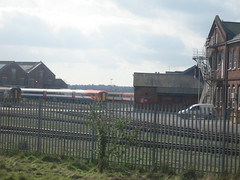
How rail privatisation failed.
Originally uploaded by seadipper.
This picture sums up the failure of Britain's railway privatisation. This was Eastleigh works, which was developed as a railway workshop from the 1890s. It was a real centre of tradition, skill and excellence, and remained so throughout the period of railway nationalisation. It was also, of course, a valuable training and employment opportunity for local people.
What happened? On privatisation, it was sold to the managers as a management buy-out and became Wessex Traincare. Their main interest was to sell the company on to the highest bidder. The eventual purchaser was the French conglomerate Alstom, which hoped to sell a fleet of new trains to South West Trains and use the works for maintenance. But in the event, Alstom's engineering resources were consumed by getting Richard Branson's tilting trains built and running, and so they were unable to give sufficient attention to ironing out the teething troubles in the 30 "Juniper" electric trains which they built for use by South West Trains.
And so SWT bought its new fleet of trains from Siemens instead, and the German company built a maintenance depot of its own near Southampton. Which meant it had no need for Eastleigh.
But all need not have been lost. Railway workshops do not need to confine their activities to train repair and construction. They have a broad skills base and can turn to a variety of light and medium engineering tasks. Eastleigh, with its proximity to Southampton, is especially well placed for this. But it didn't happen and so the works closed in March 2006.
The present use of the site illustrates another failure too. It is now used to store modern and perfectly serviceable carriages which the train companies do not want to use so that they can save money. Meanwhile, the trains are grossly overcrowded.
Kommentarer